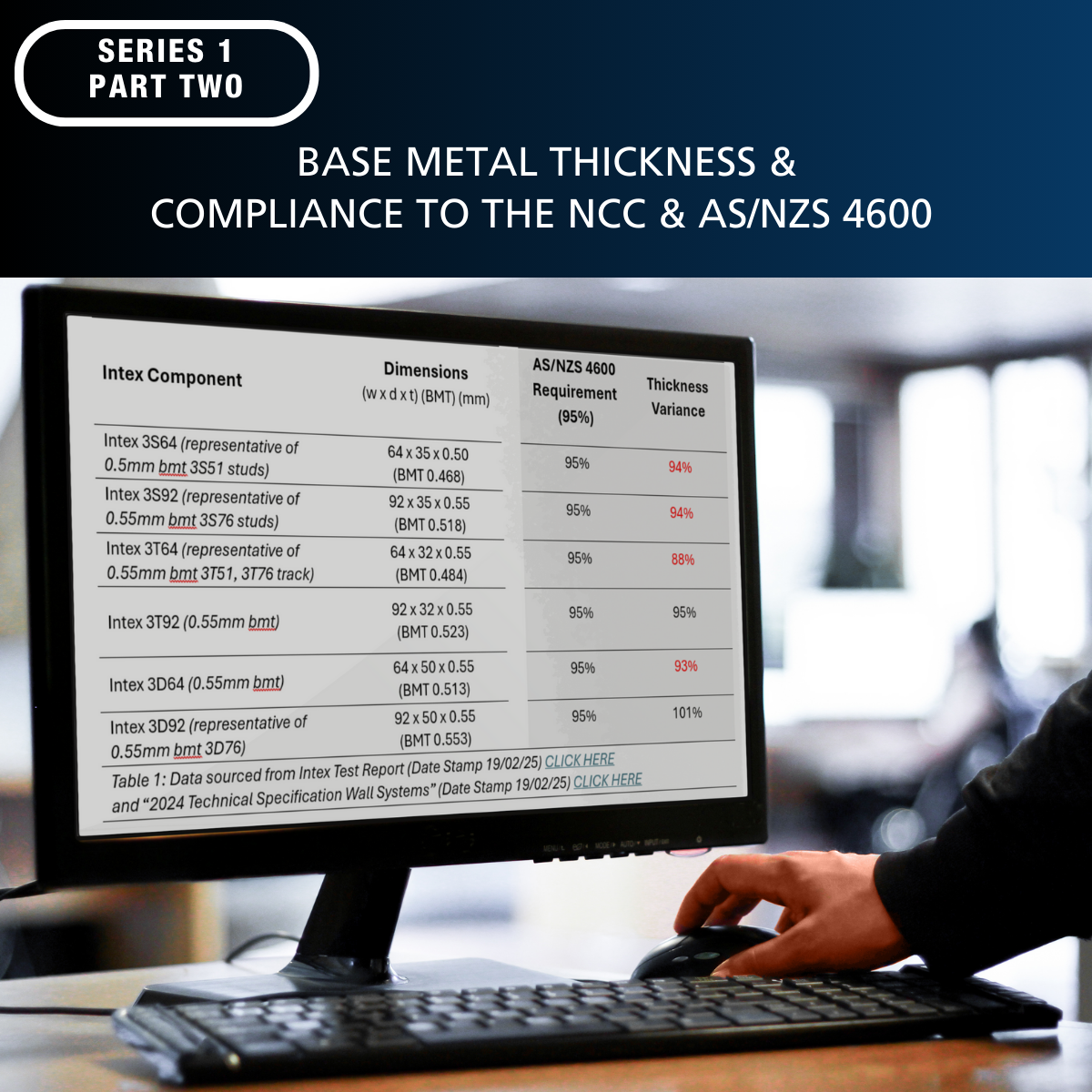For 18 months we have been investigating imported Chinese-manufactured light-gauge steel products from five suppliers in Australia. Series 1 release of our findings revealed that many of these tested imported products failed the Base Metal Thickness (BMT) requirement for compliance to AS/NZS 4600 and in-turn the Deemed to satisfy compliance pathway of the National Construction Code (NCC).
Base Metal Thickness (BMT) and Compliance Concerns
The steel’s BMT is a critical factor in determining a product's structural integrity and compliance with industry codes and standards. The Deemed to satisfy pathway of the NCC requires light gauge steel framing to be designed and compliant to AS/NZS 4600 for fire-rated and non-fire-rated walls and ceilings. AS/NZS 4600 states that the uncoated minimum steel thickness at any point in the cold-formed product, as delivered to the job site, be at least 95% of the thickness used in its design.
Our tests revealed that some imported steel products failed to comply with the above requirement, which is essential for engineering design and ensuring structural integrity of the walls and ceilings.
According to Australian steel representatives, it is understood that Chinese Steel mills aim to manufacture to the lower end of the allowable tolerance range of the Standard for Flat Rolled Steel Products. However, the steel is not typically manufactured to the tighter tolerances of AS/NZS 4600 Cold Formed Steel Structures, which is the Standard for design of Cold Formed Steel for walls and ceilings in Australia.
Investigated Products
Our investigation included products from multiple import suppliers. One typical import supplier shows publicly available test data with many instances where actual BMT falls below the required tolerance for compliance to AS/NZS 4600. This table below uses their publicly available data:
The above data sources list two BMT values: nominal (e.g., 0.50mm) and actual (e.g., 0.468mm). If the nominal BMT is used in design calculations, the BMT is outside the 95% requirement (94%), making the material and design non-compliant with AS/NZS 4600 and in-turn the Deemed to satisfy compliance pathway of the NCC.
Results from the other steel product importers we tested also showed various products having a BMT outside the AS/NZS 4600 requirement of 95%. A sample of those results are listed below.
|
Product |
Importer’s Specified BMT |
Actual BMT |
AS/NZS 4600 Requirement (95%) |
Thickness Variance |
|
H-Stud |
0.50 |
0.44 |
95% |
88% |
|
Ceiling Batten |
0.50 |
0.46 |
95% |
92% |
|
28mm Furring Channel |
0.50 |
0.45 |
95% |
90% |
|
16mm Furring Channel |
0.50 |
0.47 |
95% |
94% |
|
Wall Track |
0.50 |
0.45 |
95% |
90% |
|
64mm Steel Stud |
0.50 |
0.46 |
95% |
92% |
|
64mm Wall Track |
0.55 |
0.47 |
95% |
85% |
|
64mm Deflection Head Track |
0.50 |
0.46 |
95% |
92% |
The Dangers of Using Non-Compliant Steel
Using non-compliant steel can result in safety risks, fire compliancy failure and structural failures, particularly in fire-rated walls, external walls, and ceiling systems. Some suppliers claim their products are equivalent to Rondo steel, but our findings prove otherwise—there are major differences in many areas, including but not limited to:
✔ Base Metal Thickness (BMT)
✔ Coating protection
✔ Shape and dimensional tolerances
✔ Manufacturing quality
Many fire-rated systems rely on Rondo steel because our products were used in testing. Substituting non-compliant steel compromises the fire safety and structural performance of these systems.
As we continue our investigations, we urge builders, contractors, and designers to verify the compliance of the steel products they use. When it comes to safety and performance, cutting corners has a cost, including human safety, unwanted litigation and reputational damage.
Please note:
The information presented in the Cutting Corners Campaign is based on Rondo’s investigation of imported steel products and is current as of 19th February 2025. This investigation involved seven rounds of testing conducted at an independent laboratory on steel wall and ceiling products sourced from over five Australian suppliers importing from China. While Rondo has sought to ensure it investigated a broad sample size for the purposes of this campaign, the data and information in this article is not representative of every imported product in the Australian market. We encourage readers to conduct their own evaluation of steel products, including performance and code compliance, and not to rely on the information provided in this campaign when making purchasing decisions. If you have any questions, please contact us at rondo@rondo.com.au




